Hórreo
An hórreo is a typical granary from the northwest of the Iberian Peninsula (mainly Galicia, where it might be called a Galician granary, Asturias and Northern Portugal), built in wood or stone, raised from the ground (to keep rodents out) by pillars (pegollos in Asturian, esteos in Galician, espigueiros Portuguese, abearriak in Basque) ending in flat staddle stones (vira-ratos in Galician, mueles or tornarratos in Asturian, or zubiluzea in Basque) to prevent access by rodents. Ventilation is allowed by the slits in its walls.
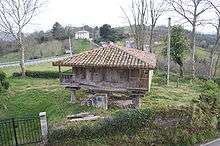
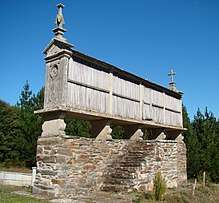
Names
In some areas, hórreos are known as horriu, horru (Asturian), horriu (Leonese), hurriu (Cantabrian), hórreo, paneira, canastro, piorno, cabazo (Galician), espigueiro, canastro, caniço, hôrreo (Portuguese), garea, garaia, garaixea (Basque).[1]
Distribution
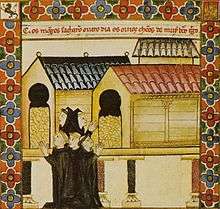
Hórreos are mainly found in the Northwest of Spain (Galicia and Asturias) and Northern Portugal. There are two main types of hórreo, rectangular-shaped, the more extended, usually found in Galicia and coastal areas of Asturias; and square-shaped hórreos from Asturias, León, western Cantabria and eastern Galicia.
Origins
The oldest document containing an image of an hórreo is the Cantigas de Santa Maria by Alfonso X "El Sabio" (song CLXXXVII) from the 13th century. In this depiction, three rectangular hórreos of gothic style are illustrated.[2]
Types
There are several types of Asturian hórreo, according to the characteristics of the roof (thatched, tiled, slate, pitched or double pitched), the materials used for the pillars or the decoration. The oldest still standing date from the 15th century, and even nowadays they are built ex novo. There are an estimated 18,000 hórreos and paneras in Asturias, some are poorly preserved but there is a growing awareness from owners and authorities to maintain them in good shape.
The longest hórreo in Galicia is located in Carnota, A Coruña, and is 35 m long.
Other similar granary structures include Asturian paneras (basically, big hórreos with more than four pillars), cabaceiras (Galician round basketwork hórreo), trojes or trojs in Castile or silos.
- A Galician hórreo.
- Hórreo of Carnota, Galicia.
 Hórreo from Cosgaya, Cantabria.
Hórreo from Cosgaya, Cantabria. Hórreo from Piornedo, Galicia.
Hórreo from Piornedo, Galicia. Corn cobs inside an hórreo, Boiro, Galicia.
Corn cobs inside an hórreo, Boiro, Galicia.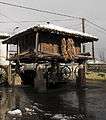 Hórreo from Siero, Asturias.
Hórreo from Siero, Asturias. Stone pillar (pegollo) standing on a footing stone (pilpayo) and capped with a staddle stone (muela).
Stone pillar (pegollo) standing on a footing stone (pilpayo) and capped with a staddle stone (muela).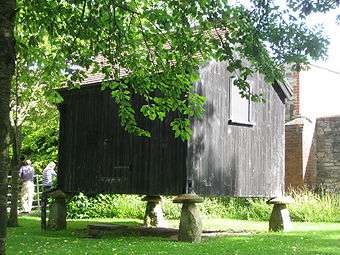 Building sitting on staddle stones, at the Somerset Rural Life Museum, similar to Iberian hórreos.
Building sitting on staddle stones, at the Somerset Rural Life Museum, similar to Iberian hórreos. Decorated granary in Ames.
Decorated granary in Ames. Brick granary in Dodro.
Brick granary in Dodro. Granary set in Combarro.
Granary set in Combarro.- Stone granary in Portuguese Soajo.
 Alvenary granary over pillars in Carnota.
Alvenary granary over pillars in Carnota. Alvenary granary over pillars and slab in Lira.
Alvenary granary over pillars and slab in Lira. Alvenary granary over barn in Rianxo.
Alvenary granary over barn in Rianxo. Mixed granary over masonry strains in Oroso.
Mixed granary over masonry strains in Oroso. Wooden granary over masonry strains in Vedra.
Wooden granary over masonry strains in Vedra.
Hórreo-like granaries in Europe
Similar granaries were common throughout Atlantic Europe: Northwest Iberian Peninsula, France, the British Isles, Scandinavia.
There are espigueiros or canastros in northern Portugal (the most famous concentration is located in Soajo).
French Savoy has its regard, also encountered in the Swiss Valais (raccard) and the Italian Aosta Valley (rascard). Norway has its stabbur, Sweden its härbre or more precisely stolphärbre or stolpbod. Hambars are found in the Balkans, and serender in northern Turkey.
Similar buildings (barns) on staddle stones are found in Southern England.
Härbren exist throughout Sweden, but the more hórreo-like härbren, raised from the ground by pillars, are only found in the central and northern parts of the country.
- Espigueiros from Arcos de Valdevez, Portugal
 Stabbur originally from Bergsrud in Sør-Aurdal, Norway later relocated to the Bautahaugen Samlinger
Stabbur originally from Bergsrud in Sør-Aurdal, Norway later relocated to the Bautahaugen Samlinger

References
- http://www.cnrtl.fr/definition/raccard
- Hórreo: granary (Spain), in Encyclopedia of Vernacular Architecture of the World (Paul Oliver ed.), Vol. 1, Theories and Principles, pp. 713-714: "Not until the 13th century, in the 'Cantigas' of Alfonso X, was there confirmation of buildings that were morphologically similar to the basic Galician hórreos."
External links
| Wikimedia Commons has media related to Hórreos. |